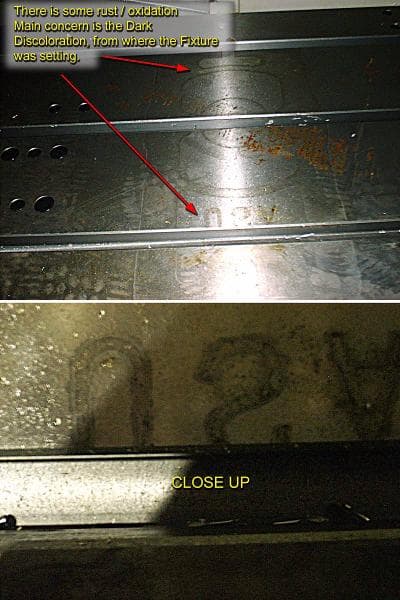
-----
Remove galvanic stains from a polished steel (cast steel, cast iron) table surface
Q. I work in the Metalworking machine tool industry. When we Demo a Machine and Place a Fixture or vise on a Clean Steel Machine Table, there is a dark blackish stain left on the table when the fixture or Vise is removed.

I suspect this discoloration is caused by Galvanic Effects. Oftentimes there are coolant/cutting fluids used, that could act as an electrolyte between the table surface and the fixture.
I'm trying to find a non-invasive, non-corrosive means to remove or lessen the discoloration while preserving the original finish of the rest of the table surface.
- Bethlehem, Pennsylvania, USA
First of two simultaneous responses --
A. What is the pH of the cutting fluid. Is there a potential difference between the cutting tool and the table? It could very well be galvanic, but could the motor be improperly grounded?

Tom Pullizzi
Falls Township, Pennsylvania
Second of two simultaneous responses --
A. (1) Try buffing with a sodium thiosulphate
⇦ on
eBay
or
Amazon [affil link]
and/or an E.D.T.A solution (Ethylene-Diamine-Tetra-Acetic-Acid or its Di-sodium equivalent). Clean/dry and oil with an anti-corrosion oil.
(2)Check the bench surface for micropitting. These pits can retain contaminants, You may need to buff the table with an aluminium oxide/borax based abrasive (tricky).
(3) Closely examine the humidity levels or corrosive vapors in your work shop. (This is common). The effect is most pronounced in the morning when the bench surface is still colder than the air (condensation).
(4) Are the demo pieces stored in a damp/ wet environment or are they picking up contamination in storage/transport (shelving etc).
(5) Are the demo pieces brought in colder than the air in the work shop. If they are, you risk condensation. (This may not even be discernible).
Points (3)-(5) are the most common causes (and too obvious in hindsight).
- Ireland
Q, A, or Comment on THIS thread -or- Start a NEW Thread